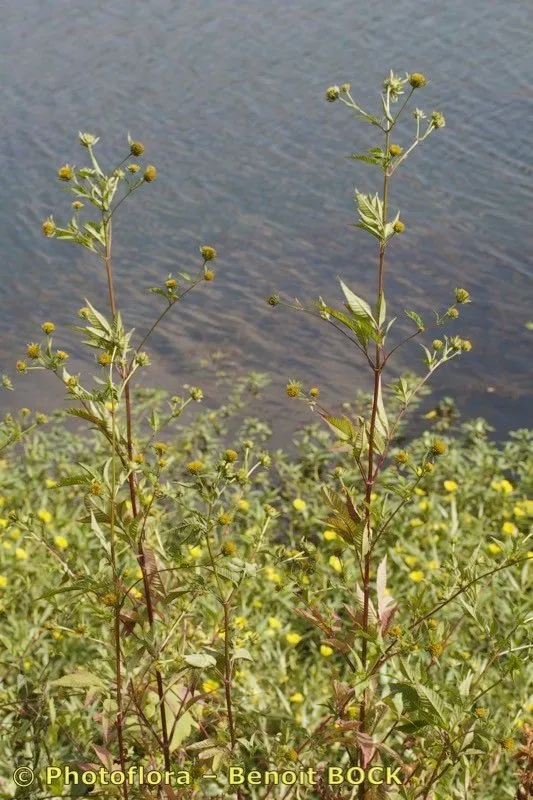
Author: Greene
Bibliography: Pittonia 4(21): 72 (1899)
Year: 1899
Status: accepted
Rank: species
Genus: Bidens
Vegetable: False
Observations: Canada to U.S.A.
Tall beggar-ticks, scientifically known as Bidens vulgata, is a notable plant belonging to the Asteraceae family. This plant, first described in detail by Greene in the bibliographic reference Pittonia 4(21): 72 (1899), is primarily observed across a wide geographic range, spanning from Canada to the United States.
The Tall beggar-ticks plant is well-adapted to various environments within these regions, thriving in both natural and disturbed habitats which often include marshes, wetlands, and meadows. As a member of the Asteraceae family, it shares common characteristics with other daisy-like flowering plants, exhibiting a composite inflorescence that comprises multiple small flowers grouped together to form what appears to be a single flower head.
This species is particularly distinguished by its tall and erect stature, often reaching impressive heights. The leaves of Bidens vulgata are typically oppositely arranged, with serrated margins that contribute to its distinctive appearance. The flowers are usually yellow, radiating from the central disk, which, upon maturation, give rise to seeds equipped with barbed bristles. These bristles are highly effective in hitching rides on passing animals or humans, thus aiding in seed dispersal—a characteristic trait referenced by the common name “beggar-ticks.”
Beyond its ecological role, the plant has drawn attention due to its potential impact on agriculture and its ability to thrive in various environments, often leading it to be considered a weed in some regions. Its presence, however, is also a testament to the resilience and adaptability of the Asteraceae family.
Understanding the distribution and characteristics of Bidens vulgata not only enriches botanical knowledge but also aids in managing its spread in environments where it may present challenges. The detailed description and observation dates back to Greene’s work at the turn of the 20th century, reflecting the long-standing interest and importance of this species in botanical studies.
Deu: amerikanischer zweizahn
Fra: bident répandu, bident vulgaire
Eng: big devil’s beggartick, tall beggar-ticks, tall beggarticks, western sticktight, big devil’s beggarticks, bur-marigold, common beggarticks, downy beggarticks, tall beggars’ ticks, tall burr marigold
Swe: västskära
En: Tall beggar-ticks, Big devil’s beggartick, Tall beggarticks, Western sticktight, Bur-Marigold, Tall beggars’ ticks, Big devil’s beggarticks, Common beggarticks, Downy beggarticks, Tall burr marigold, Big devils beggartick
Fr: Bident vulgaire, Bident répandu
De: Amerikanischer Zweizahn
Sv: Västskära
© copyright of the Board of Trustees of the Royal Botanic Gardens, Kew.
© copyright of the Board of Trustees of the Royal Botanic Gardens, Kew.
© copyright of the Board of Trustees of the Royal Botanic Gardens, Kew.
Taken Sep 15, 2009 by Photoflora – Benoit BOCK (©)
Taken Sep 15, 2004 by Photoflora – Benoit BOCK (©)
Taken Sep 8, 2018 by Tela Botanica − Patrick Ressayre (cc-by-sa)
Taken Aug 8, 2021 by Jessica Gaber (cc-by-sa)
Taken Oct 14, 2019 by Franco Colnago (cc-by-sa)
Taken Sep 15, 2004 by Photoflora – Jean-Luc TASSET (©)
Taken Sep 15, 2004 by Photoflora – Benoit BOCK (©)
Taken Oct 15, 2004 by Photoflora – Benoit BOCK (©)
Taken Sep 15, 2004 by Photoflora – Benoit BOCK (©)
Taken Oct 14, 2019 by Franco Colnago (cc-by-sa)
Taken Sep 15, 2009 by Photoflora – Benoit BOCK (©)
Taken Sep 15, 2009 by Photoflora – Benoit BOCK (©)
Taken Sep 8, 2018 by Tela Botanica − Patrick Ressayre (cc-by-sa)
Taken Aug 8, 2021 by Jessica Gaber (cc-by-sa)
Taken Aug 8, 2021 by Jessica Gaber (cc-by-sa)
Taken Oct 15, 2004 by Photoflora – Benoit BOCK (©)
Taken Sep 15, 2004 by Photoflora – Benoit BOCK (©)
Taken Sep 15, 2004 by Photoflora – Benoit BOCK (©)
Taken Sep 15, 2004 by Photoflora – Benoit BOCK (©)
Taken Sep 15, 2009 by Photoflora – Benoit BOCK (©)
Taken Sep 15, 2019 by Photoflora – Benoit BOCK (©)
Taken Sep 15, 2019 by Photoflora – Benoit BOCK (©)
Taken Sep 15, 2009 by Photoflora – Benoit BOCK (©)
Taken Sep 15, 2004 by Photoflora – Benoit BOCK (©)
Taken Sep 15, 2004 by Photoflora – Benoit BOCK (©)
Taken Sep 8, 2018 by Tela Botanica − Patrick Ressayre (cc-by-sa)
Growth habit>: Forb/herb
Ph maximum: 7.5
Ph minimum: 7.0
Light: 8
Atmospheric humidity: 7
Soil nutriments: 8
Family: Myrtaceae Author: (F.Muell.) K.D.Hill & L.A.S.Johnson Bibliography: Telopea 6: 402 (1995) Year: 1995 Status:…
Family: Rubiaceae Author: Pierre ex A.Froehner Bibliography: Notizbl. Bot. Gart. Berlin-Dahlem 1: 237 (1897) Year:…
Family: Sapindaceae Author: Koidz. Bibliography: J. Coll. Sci. Imp. Univ. Tokyo 32(1): 38 (1911) Year:…
Family: Asteraceae Author: A.Gray Bibliography: Pacif. Railr. Rep.: 107 (1857) Year: 1857 Status: accepted Rank:…
Family: Fabaceae Author: Medik. Bibliography: Vorles. Churpfälz. Phys.-Ökon. Ges. 2: 398 (1787) Year: 1787 Status:…
Family: Aspleniaceae Author: (Cav.) Alston Bibliography: Bull. Misc. Inform. Kew 1932: 309 (1932) Year: 1932…